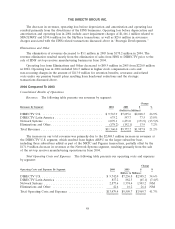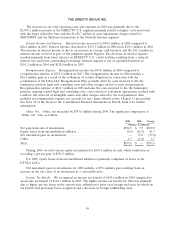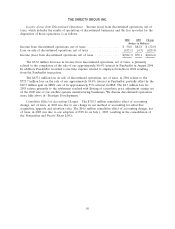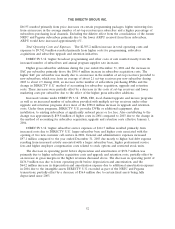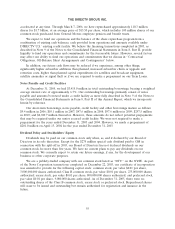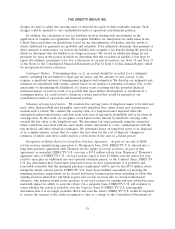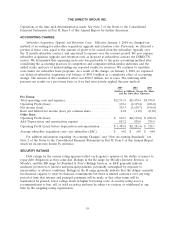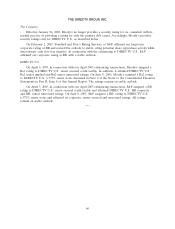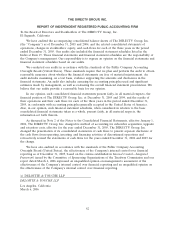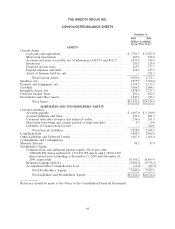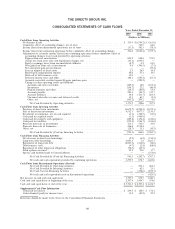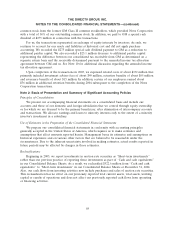DIRECTV 2005 Annual Report Download - page 71
Download and view the complete annual report
Please find page 71 of the 2005 DIRECTV annual report below. You can navigate through the pages in the report by either clicking on the pages listed below, or by using the keyword search tool below to find specific information within the annual report.THE DIRECTV GROUP, INC.
charges in order to adjust the carrying value of deferred tax assets to their realizable amount. Such
charges could be material to our consolidated results of operations and financial position.
In addition, the calculation of our tax liabilities involves dealing with uncertainties in the
application of complex tax regulations. We recognize liabilities for anticipated tax audit issues in the
United States and other tax jurisdictions based on our determination of whether, and the extent to
which, additional tax payments are probable and estimable. If we ultimately determine that payment of
these amounts is unnecessary, we reverse the liability and recognize a tax benefit during the period in
which we determine that the liability is no longer necessary. We record an additional charge in our
provision for taxes in the period in which we determine that the recorded tax liability is less than we
expect the ultimate assessment to be. For a discussion of current tax matters, see Note 10 and Note 21
of the Notes to the Consolidated Financial Statements in Part II, Item 8 of this Annual Report, which
we incorporate herein by reference.
Contingent Matters. Determining when, or if, an accrual should be recorded for a contingent
matter, including but not limited to legal and tax issues, and the amount of such accrual, if any,
requires a significant amount of management judgment and estimation. We develop our judgment and
estimates in consultation with outside counsel based on an analysis of potential outcomes. Due to the
uncertainty of determining the likelihood of a future event occurring and the potential financial
statement impact of such an event, it is possible that upon further development or resolution of a
contingent matter, we could record a charge in a future period that would be material to our
consolidated results of operations and financial position.
Valuation of Long-Lived Assets. We evaluate the carrying value of long-lived assets to be held and
used, other than goodwill and intangible assets with indefinite lives, when events and circumstances
warrant such a review. We consider the carrying value of a long-lived asset impaired when the
anticipated undiscounted future cash flow from such asset is separately identifiable and is less than its
carrying value. In that event, we recognize a loss based on the amount by which the carrying value
exceeds the fair value of the long-lived asset. We determine fair value primarily using the estimated
future cash flows associated with the asset under review, discounted at a rate commensurate with the
risk involved, and other valuation techniques. We determine losses on long-lived assets to be disposed
of in a similar manner, except that we reduce the fair value for the cost of disposal. Changes in
estimates of future cash flows could result in a write-down of the asset in a future period.
Recognition of Rebate Related to Long-Term Purchase Agreement. As part of our sale of HNS’
set-top receiver manufacturing operations to Thomson in June 2004, DIRECTV U.S. entered into a
long-term purchase agreement with Thomson for the supply of set-top receivers. As part of this
agreement, as amended, DIRECTV U.S. can earn a $57.0 million rebate from Thomson if Thomson’s
aggregate sales of DIRECTV U.S.’ set-top receivers equal at least $4 billion over the initial five year
contract term plus an additional one year optional extension period, or the Contract Term. DIRECTV
U.S. has determined that, based upon projected set-top receiver requirements, it is probable and
reasonably estimable that the minimum purchase requirement will be met for the $57.0 million rebate
during the initial contract period. DIRECTV U.S. bases its probability assessment for meeting the
minimum purchase requirement on its current and future business projections, including its belief that
existing and new subscribers will likely acquire new set-top receivers due to certain technological
advances. Any negative trends in the purchase of set-top receivers for existing and new subscribers may
materially impact its ability to earn the rebate. On a quarterly basis, DIRECTV U.S. will continue to
assess whether the rebate is probable over the Contract Term. If DIRECTV U.S. subsequently
determines that it is no longer probable that it will earn the rebate, DIRECTV U.S. would be required
to reverse the amount of the credit recognized to date as a charge to the Consolidated Statements of
58


